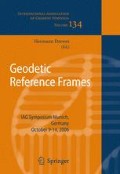Abstract
ITRF2005 is the first realization of the International Terrestrial Reference Frame (ITRF) using a time series combination of multi-technique solutions to yield fully consistent station positions and Earth orientation parameters (EOPs), with full variance-covariance information. However, it is not as easy to combine universal time (UT1) and length of day (LOD) as for polar motion within the ITRF combination itself. Only the UT1 and LOD results from 24-hr very long baseline interferometry (VLBI) sessions have been included because the denser set of short-duration, single-baseline VLBI sessions can distort station position estimates and daily satellite-based LOD estimates suffer from large, time-varying biases.
This paper outlines a multi-step procedure to utilize all the available UT1 and LOD results to produce a nearly optimal, complete time series combination consistent with ITRF2005: 1) The ITRF2005 solution for VLBI station positions and velocities, as well as daily polar motion and UT1/LOD at VLBI epochs, is adopted with associated variance-covariances. 2) The short-duration, single-baseline VLBI sessions must be reduced to SINEX form with UT1 freely adjusted and with station positions and polar motion constrained to the ITRF2005 values. Alternatively and probably better, the initial VLBI analyses can use non-ITRF constraints, which must later be modified by back-substitution, provided that all the necessary a priori information is included in the session SINEX files. 3) The set of ITRF2005 UT1/LOD estimates and sigmas merged with those from the short-duration VLBI sessions should form a consistent time series, but only at VLBI epochs. 4) Biased LOD estimates from satellite techniques can be used to densify and regularize the epochs of VLBI UT1 estimates in a Kalman filter. In addition to coupled models for the stochastic variations of LOD (random walk) and UT1 (integrated random walk) due to geophysical processes, an empirical stochastic model is needed for each satellite technique to account for the behavior of its LOD biases.
The resulting Kalman filter output of UT1 and LOD estimates and sigmas will be optimal in the general estimation sense, assuming reasonable stochastic models and parameters are derived for the satellite LOD biases, and will be quasi-optimal as they relate to the ITRF2005 frame. But more specifically and importantly, unbiased estimates and realistic sigmas are ensured by the direct modeling of the LOD biases, unlike in simpler methods that “calibrate” the biases in a pre-combination step.
Access this chapter
Tax calculation will be finalised at checkout
Purchases are for personal use only
Preview
Unable to display preview. Download preview PDF.
References
Altamimi, Z., X. Collilieux, and C. Boucher (2006). Preliminary analysis in view of the ITRF2005. In: The Dynamic Planet 2005, proc. of 2005 IAG/IAPSO/IABO Joint Assemnly, IAG Symposia, Vol. 130, in press.
Gross, R. (2005). Combinations of Earth orientation measurements: SPACE2004, COMB2004, and POLE2004. Jet Propulsion Lab., publication 05-6, Pasadena, CA, 20 pp.
Mireault, Y., J. Kouba, and J. Ray (1999), IGS Earth rotation parameters. GPS Solutions, 3(1), pp. 59-72.
Morabito, D.D., T.M. Eubanks, and J.A. Steppe (1988). Kalman filtering of Earth orientation changes. In: The Earth’s Rotation and Reference Frames for Geodesy and Geodynamics. A.K. Babcock and G.A. Wilkins (eds), Kluwer Acad., Norwell, Mass., pp. 257-267.
Ray, J.R., W.E. Carter, and D.S. Robertson (1995). Assessment of the accuracy of daily UT1 determinations by Very Long Baseline Interferometry. J. Geophys. Res., 100(B5), pp. 8193-8200.
Ray, J.R. (1996). Measurements of length of day using the Global Positioning System. J. Geophys. Res., 101(B9), pp. 20141-20149.
Ray, J., J. Kouba, and Z. Altamimi (2005). Is there utility in rigorous combinations of VLBI and GPS EOPs?, J. of Geodesy, doi: 10.1007/s00190-005-0007-7, 79(9), pp. 505-511.
Author information
Authors and Affiliations
Editor information
Editors and Affiliations
Rights and permissions
Copyright information
© 2009 Springer-Verlag Berlin Heidelberg
About this chapter
Cite this chapter
Ray, J. (2009). A Quasi-Optimal, Consistent Approach for Combination of UT1 and LOD. In: Drewes, H. (eds) Geodetic Reference Frames. International Association of Geodesy Symposia, vol 134. Springer, Berlin, Heidelberg. https://doi.org/10.1007/978-3-642-00860-3_37
Download citation
DOI: https://doi.org/10.1007/978-3-642-00860-3_37
Published:
Publisher Name: Springer, Berlin, Heidelberg
Print ISBN: 978-3-642-00859-7
Online ISBN: 978-3-642-00860-3
eBook Packages: Earth and Environmental ScienceEarth and Environmental Science (R0)

